Ceylon sago, False sago
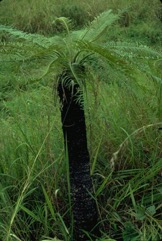
A tropical plant. They occur in tropical lowland areas in grassland and forest. They grow from sea level to 700 m altitude. They are more common in places with a dry seasonal climate. It suits hardiness zones 9-11.
Also known as:
Babai, Bait, Bogak, Chatale, Fadang, Godduyicalu, Kama, Kilakora, Laupama, Maphrao-sida, Mondaing, Mong-tain, Mwaere, Nyia nwasipoyi, Paipai ro, Paiyindu, Pakas raja, Pakis haji, Paku gajah, Paku laut, Patorr, Pitogo, Pitugo, Prong-tha-le, Prong, Queen sago, Ranaguvva, Rosaimaro, Ruvoruvo, Sikas pakis haji, Sikas ratu sagu, Sauang, Takwaruru, Taronarona, Thien tue, Tutappana
Synonyms
- Cycas circinalis L.
Edible Portion
- Seeds, Leaves, Stem starch
Where does Ceylon sago grow?
Found in: Asia, Andamans, Australia, Cambodia, China, Christmas Island, East Timor, Fiji, Guam, India, Indochina, Indonesia, Malaysia, Micronesia, Myanmar, New Caledonia, Pacific, Pakistan, Palau, Papua New Guinea, PNG, Philippines, SE Asia, Slovenia, Solomon Islands, Sri Lanka, Thailand, Timor-Leste, Tuvalu, Vietnam
Notes: There are about 20-40 Cycas species. In Slovenia possibly in hot house.
Growing Ceylon sago, False sago
Cultivation: They can be grown from seeds. Plants, especially damaged ones produce suckers.
Edible Uses: The pith is processed to extract the starch during times of food shortage. The seeds are sometimes eaten after treatment by slicing, fermenting for 2 weeks and then cooking. They can be used for flour. The very young unfolded leaves are cooked and eaten in Malaysia. CAUTION The young leaves are poisonous to cattle. The seeds are poisonous unless treated. They contain a toxic glucoside. They contain Hydrocyanic acid.
Production: It is a slow growing plant. Plants for sago need to be 7 years old and not to have flowered.
Nutrition Info
per 100g edible portion| Edible Part | Energy (kcal) | Protein (g) | Iron (mg) | Vitamin A (ug) | Vitamin c (mg) | Zinc (mg) | % Water |
|---|---|---|---|---|---|---|---|
| - | - | - | - | - | - |
Ceylon sago, False sago Photos

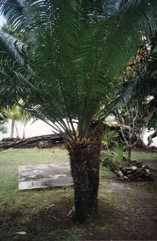
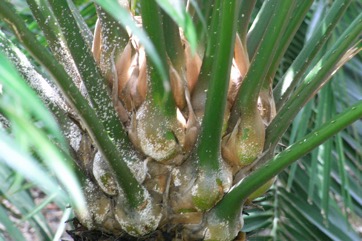
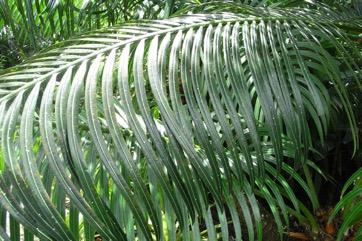
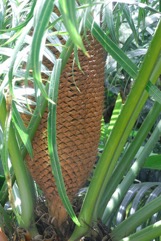
References
Ambasta, S.P. (Ed.), 2000, The Useful Plants of India. CSIR India. p 153
Arora, K., Indigenous Forest Management in the Andaman and Nicobar Islands, India.
Awasthi, A.K., 1991, Ethnobotanical studies of the Negrito Islanders of Andaman Islands, India - The Great Andamanese. Economic Botany 45(2) pp 274-280.
Barrau, J., 1976, Subsistence Agriculture in Polynesia and Micronesia. Bernice P. Bishop Museu, Bulletin 223 Honolulu Hawaii. Kraus reprint. p 55
Bhargava, N., 1983, Ethnobotanical Studies of the Tribes of Andaman and Nicobar Islands, India. 1. Onge. Economic Botany 37(1): 110-119
Borrell, O.W., 1989, An Annotated Checklist of the Flora of Kairiru Island, New Guinea. Marcellin College, Victoria Australia. p 11, 153
Bull. Sci. Phys. Nat. Neerl. 2:45. 1839
Clarke, W.C. & Thaman, R.R., 1993, Agroforestry in the Pacific Islands: Systems for sustainability. United Nations University Press. New York. p 235
Cowie, I, 2006, A Survey of Flora and vegetation of the proposed Jaco-Tutuala-Lore National Park. Timor-Lests (East Timor) www.territorystories.nt/gov.au p 46
Cundall, P., (ed.), 2004, Gardening Australia: flora: the gardener's bible. ABC Books. p 449
French, B.R., 1986, Food Plants of Papua New Guinea, A Compendium. Asia Pacific Science Foundation p 339
Henderson, C.P. and I.R.Hancock, 1988, A Guide to the Useful Plants of the Solomon Islands. Res. Dept. Min of Ag. & Lands. Honiara, Solomon Islands. p 138
Henty, E.E., 1980, Harmful Plants in Papua New Guinea. Botany Bulletin No 12. Division Botany, Lae, Papua New Guinea. p 44
Hibbert, M., 2002, The Aussie Plant Finder 2002, Florilegium. p 79
Jones, D.L., 2000, Cycads of the world. Reed New Holland. p 156
Lepofsky, D., 1992, Arboriculture in the Mussau Islands, Bismarck Archipelago. Economic Botany, Vol 46, No. 2, pp. 192-211
Marinelli, J. (Ed), 2004, Plant. DK. p 366
Martin, F.W. & Ruberte, R.M., 1979, Edible Leaves of the Tropics. Antillian College Press, Mayaguez, Puerto Rico. p 190
Menninger, E.A., 1977, Edible Nuts of the World. Horticultural Books. Florida p 162
Nombo, P. & Leach, J. 2010, Reite Plants: An Ethnobotanical Study in Tok Pisin and English. ANU press. p 115
Ochse, J.J. et al, 1931, Vegetables of the Dutch East Indies. Asher reprint. p 215
Peekel, P.G., 1984, (Translation E.E.Henty), Flora of the Bismarck Archipelago for Naturalists, Division of Botany, Lae, PNG. p 35, 33
Phon, P., 2000, Plants used in Cambodia. © Pauline Dy Phon, Phnom Penh, Cambodia. p 187
Pham-Hoang Ho, 1999, An Illustrated Flora of Vietnam. Nha Xuat Ban Tre. p 214
READ,
Sukarya, D. G., (Ed.) 2013, 3,500 Plant Species of the Botanic Gardens of Indonesia. LIPI p 826
Thaman, R. R, 2016, The flora of Tuvalu. Atoll Research Bulletin No. 611. Smithsonian Institute p 33
Verheij, E. W. M. and Coronel, R.E., (Eds.), 1991, Plant Resources of South-East Asia. PROSEA No 2. Edible fruits and nuts. Pudoc Wageningen. p 327
Walter, A. & Lebot, V., 2007, Gardens of Oceania. ACIAR Monograph No. 122. p 157
Wickens, G.E., 1995, Edible Nuts. FAO Non-wood forest products. FAO, Rome. p173
World Checklist of Useful Plant Species 2020. Royal Botanic Gardens, Kew